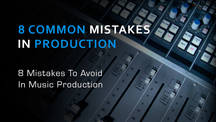So you're ready to record, mix and master that song/album/soundtrack? Joe Albano is here to ensure you don't succumb to any common pitfalls during the process. These tips should help...
Throughout the entire production process of setup, recording, mixing, and mastering, there are any number of problems that can crop up, or mistakes that can be made, that can negatively impact on the final results. Here are 8 quick suggestions—mistakes to avoid—to keep a project on track to a successful conclusion.
1. Setup: Don’t wear too many hats
A lot of people—especially those operating their own personal studios—find themselves taking on all the roles: recording engineer, assistant, musician, producer, mixer, mastering engineer. This can work—I’ve done it myself—but it also can lead to less-than-ideal situations and results. When you’re trying to do everything, it’s easy to miss critical details during parts of the process, and those oversights can come back to haunt you—while watching the meter to insure good levels, you might miss a performance flub that sticks out later; while mixing a track you’ve heard dozens of times, you may inadvertently gloss over a small glitch or mistake you’ve gotten used to; etc. Even if you can’t afford to hire on extra personnel, it may be possible to find friends willing to help or students willing to intern, to take on the less-critical tasks, freeing you up to focus on the most important details.
2. Setup: Don’t skimp on the monitoring
Every decision you make throughout a project is based on what you hear through the monitors, so this is one area that really can’t afford to be given short shrift. Don’t rely on some old hi-fi speakers, to save a few bucks—studio monitors are designed for a more neutral response than consumer products, and that’s key to letting you know what the tracks and mixes actually sound like—what’s good and what needs to be tweaked. But even good studio monitors have their own coloration, and the room adds to this, so it’s a good idea to check the sound on different speakers (and headphones) to get a more accurate picture of what’s actually in the recordings, as opposed to what the equipment and room may be doing to the sound.

Fig 1 Monitoring is key—appropriate studio monitors and good musicians’ headphone mixes can make a big difference
3. Recording: Don’t ignore the performers’ monitor mix
Just as you depend on what you hear on the studio monitors, the performers depend on what they hear in their headphone mixes. If the blend of backing tracks and the balance between them and the performer’s own voice or instrument isn’t ideal, it can negatively impact the performance—singers may strain, players may over- or under-play, vocalists may go off pitch—any number of musical flaws can result from a poor monitor mix. Performers may not want to complain, or not be able to articulate what’s not right (from a suitably technical standpoint), so you (or your trusted assistant engineer) need to put on a set of cans and check the monitor mixes carefully, making sure everything is optimal for each particular recording, before hitting the big red button.
4. Recording: Don’t commit to processing on the way in

Fig 2 Processing added to a recording on the way in can often turn out to be too much later on at the mix stage—a gentle hand is best
Often, during tracking, you may feel that you’ll want to EQ this instrument, or compress that vocal, later on in the mix, so it’s tempting to do it right there, especially if you have one or two nice pieces of hardware you’re dying to to use. But there’s always the danger that any processing you commit to before the tracks are all blended together may just not work well in the final mix, and it’s not always easy (or possible!) to undo it (especially over-compression). Experienced recordists know just how much they can get away with—say, just how much gentle compression or limiting is enough to control a performer’s dynamic swings, but still remain transparent, without imparting too much “squash” to the recording. If you’re not at that point yet, it’s probably better to avoid committing until the mix. You could run a separate processed feed to the monitor mix, if you’re confident that hearing the processed signal might help the performer out, or you could record two tracks—one dry, one processed—to give yourself an out later, if needed. This last is commonly done with instruments like electric guitar and bass, where the player needs to hear the effect of the amp to play an appropriate part, but you might want to leave your options open, in case that sound proves to be too much, or just wrong, for the mix later on.
5. Recording: Don’t “fix it in the mix”
That phrase is an old recording industry joke—anything that doesn’t sound perfect going down will get fixed in a later stage of the process. But while today’s tools (auto-tuning, time-shifting, etc.) provide more corrective options than ever, that’s still not the best approach—you really want each track to be as well-recorded as possible, so in the mix you can focus on creative processing, rather than corrective tasks. This doesn’t mean I think you should process the audio during tracking to have a “finished” quality—the previous tip still holds. But with considerations like instrument tuning, vocal intonation, consistent tonality, musically-appropriate performance dynamics, and the like, you should strive to get these right at the source, and not depend on that virtual toolbox of modern toys to edit, squeeze, twist, and coax them out of less-than-ideal tracks later on, when you should be focused on mixing.
6. Mixing: Don’t mix the same day as recording & editing
This might not always be an option, but whenever possible, it’s a good idea to avoid mixing the same day you just finished recording and editing the tracks. Your head will be in one place—individual musical and technical details—but you need to shift to another—the big picture. It’s hard to shake off that individual focus on particular parts or edits, and be able to hear those tracks in the larger context of the full arrangement, as you need to for the mix. I’ve found that, whenever I did a mix immediately after, say, finishing a complex, time-consuming edit (like a comp or harmony edit), I always inadvertently made that track too loud in the mix. Subconsciously, I was so used to hearing the minutiae of that track, that my ear told me I still needed to hear all that detail even within the mix, when the track should have been buried just a bit, for a more appropriate blend. I’d always immediately pick up on this the next day, when I listened to the mix with fresh ears. Starting the mix a day later can alleviate this, but if that’s not possible, then taking a break is really important, before switching hats. Most mixers have their own tricks to shake off the subconscious focus on detail, and clear their heads—take a walk, play other music, listen to the mix from another room. Whatever works for you, it can make a big difference, and save a lot of hand-wringing the next day.
7. Mixing: Don’t try to make a mix sound like a master

Fig 3 Engineers are split over whether to add stereo bus processing in the mix, or leave it until the mastering stage
It can be good practice—especially for novice mixers—to reference your mix(es) to commercial recordings—it helps you get that “sound” of commercial recordings in your ears. But nowadays, there’s a potential pitfall to doing this. Modern commercial releases are heavily mastered—overall EQ, compression and limiting is applied, as a final step. This is all well and good (arguments about current mastering practices aside for a moment), but you can’t really get that sound without specialized mastering tools, and your mix won’t (and shouldn’t) necessarily have that sound until mastering is applied, at the very end of the entire process (if you heard those commercial mixes before they were mastered, you see that they didn’t always have that quality on their own, either). Because of the trend toward loudness maximizing, the pre-mastered mix can (and should) have more dynamic range and transient punch that is possible once its level has been cranked up to be competitive with the boosted levels of most commercial releases—it’s normal for the finished mix to be around 8-10 dB lower in average level that it will be once mastering has been applied. Though many mix engineers do apply mastering-type processing (compression, limiting) to the stereo output (LR) mix bus, many others avoid this in the mix, except as a reference, to anticipate the possible effects of the mastering to come. Most mastering engineers prefer mixes without master bus processing, which can tie their hands—I feel it’s best to leave that to the final stage, and avoid it in the mix.
8. Mastering: Don’t master your own mixes

Fig 4 A proper mastering facility and engineer brings not only fresh ears, but experience and a reliable monitoring environment to the important final step of the production process
And that brings us to my last suggestion—if possible, don’t master your own mixes. While many of us do wear both hats (I’ve had to for many projects), ideally, it would be good to have a fresh set of ears take on that final stage of production. Besides bringing years of experience to what can be a “black art”, a dedicated mastering engineer will hear the mix fresh, as eventual listeners will. The mixer, by the time the mix is done, will have heard those tracks hundreds of times (even more if he was also the tracking engineer and/or (one of) the artist(s))! No matter how good you are, after you’ve heard something so many times, you will subconsciously gloss over details your ears have simply become accustomed to, that a set of fresh ears will pick up on immediately. Since mastering is the last chance to address such issues, it pays to have a fresh perspective. If that’s not possible, at the very least, just as between recording/editing and mixing, it would be a good idea to take a break when the mix is done, and come back the next day to do the mastering. You may not have an entirely new perspective, but you will bring fresh(er) ears to that important final step of the long production journey.
And that’s all we have space for in the scope of this article. Hopefully, some of these suggestions will be helpful to some of you out there, especially those one-man/one-woman acts who, despite juggling all those hats, still want the absolute best results for their musical projects!
Original Source: Here









